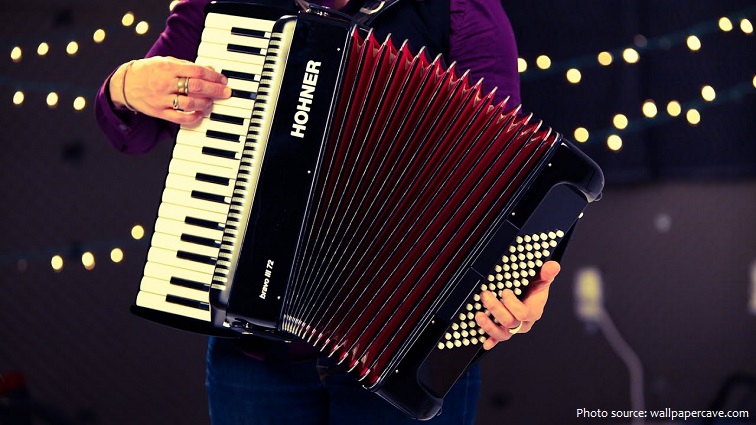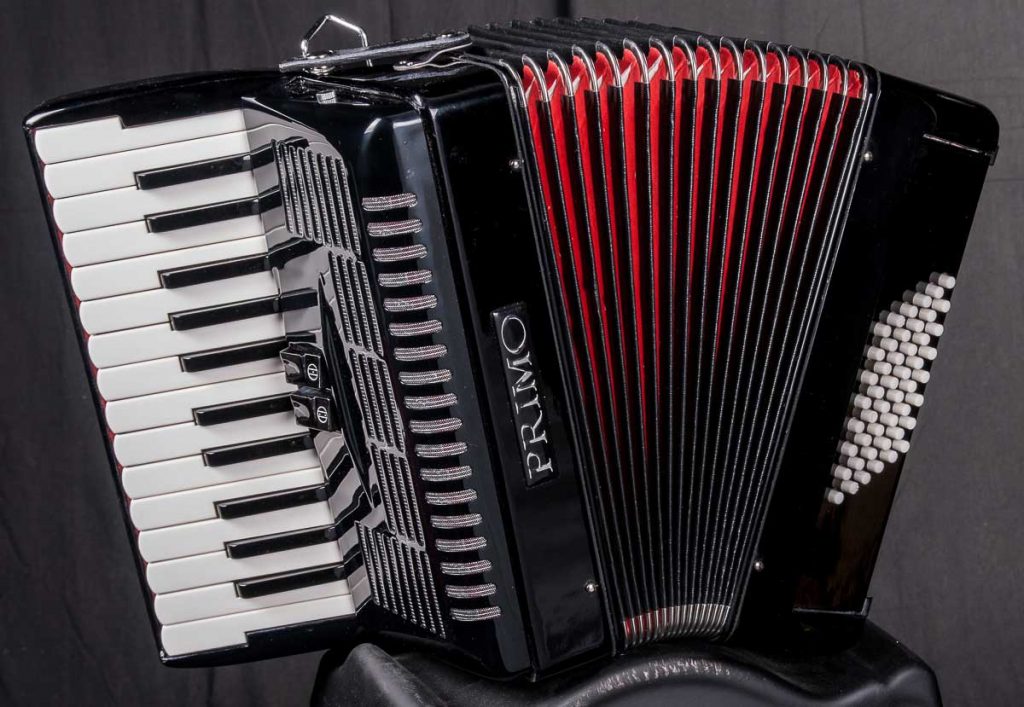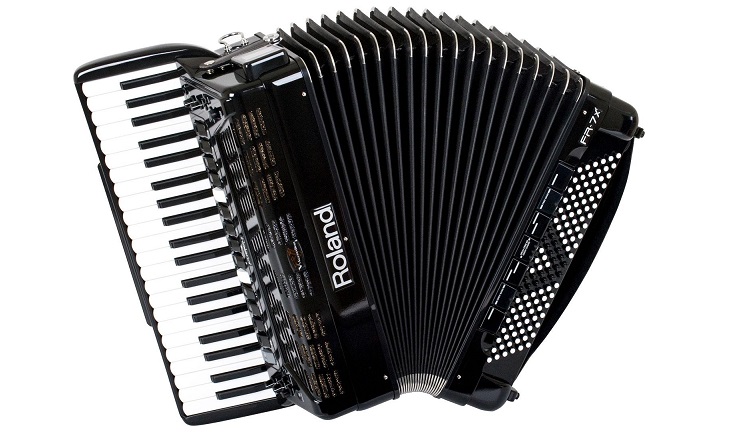
The accordion is a musical instrument operated by air pressure, belonging to the family of theaerophones.
It consists of three different parts: the right hand keyboard for the melody, the bellows, and the left hand keyboard (or buttons) for the accompaniment.
The accordion is played by compressing or expanding the bellows while pressing buttons or keys, causing pallets to open, which allow air to flow across strips of brass or steel, called reeds. These vibrate to produce sound inside the body. Valves on opposing reeds of each note are used to make the
instrument’s reeds sound louder without air leaking from each reed block. The performer normally plays the melody on buttons or keys on the right-hand manual, and the accompaniment, consisting of bass and pre-set chord buttons, on the left-hand manual.

Accordions have many configurations and types. What may be easy to do with one type of accordion could be technically challenging or impossible with another, and proficiency with one layout may not translate to another.
The most obvious difference between accordions is their right-hand manuals:
• Piano accordions use a piano-style musical keyboard
• Button accordions use a buttonboard – they are furthermore differentiated by their usage of a chromatic or diatonic buttonboard for the right-hand manual.
Accordions are sized according to the number of bass buttons, 12 bass, 48 bass 72 bass and 120 bass being the most common sizes. Other sizes are available but they all still follow the same pattern of bass buttons.

The advent of the accordion is the subject of debate among researchers. Many credit C. Friedrich L. Buschmann, whose Handäoline was patented in Berlin in 1822, as the inventor of the accordion, while others give the distinction to Cyril Demian of Vienna, who patented his Accordion in 1829, thus coining the name. A modification of the Handäoline, Demian’s invention comprised a small manual bellows and five keys, although, as Demian noted in a description of the instrument, extra keys could
be incorporated into the design. Numerous variations of the device soon followed.
The instrument was noted in The Times in 1831 as one new to British audiences and was not favourably reviewed, but nevertheless it soon became popular. It had also become popular with New Yorkers by the
mid-1840s.

The accordion is widely spread across the world because of the waves of immigration from Europe to the Americas and other regions.
In some countries (for example Brazil, Colombia, Dominican Republic, Mexico and Panama) it is used in popular music, whereas in other regions (such as Europe, North America and other countries in South America) it tends to be more used for dance-pop and folk music and is often used in folk music in Europe, North America and South America.
Although best known as a folk instrument, it has grown in popularity among classical composers. The earliest surviving concert piece is Thême varié très brillant pour accordéon methode Reisner, written in 1836 by Louise Reisner of Paris. Other composers, including the Russian Pyotr Ilyich Tchaikovsky, the Italian Umberto Giordano, and the American Charles Ives, wrote works for the diatonic button accordion.

The accordion appeared in popular music from the 1900s to the 1960s. This half-century is often called the “golden age of the accordion”.
The Italian name “fisarmonica” is derived from the German word “Physharmonikaz,” a compound name coming from the Greek word “Physa” – bellows – and “Harmonikos” – harmonic.
The most expensive accordions are typically fully hand-made, particularly the reeds – completely hand-made reeds have a better tonal quality than even the best automatically manufactured ones.
The Pigini Mythos accordion is the most expensive of any accordions, and is worth a cool $40,000. What makes this accordion stand out among the others, is the deep, velvety, rich tones in which it is known for.

The number of accordionists in China exceed every other country in the world, and possibly every country combined. Introduced in 1926, the accordion has rose to popularity in China throughout the years, thanks to Russian teachers and being a popular instrument in the People’s Liberation Army, and remains very popular.
The largest playable accordion in the world is 2.53 m (8 ft 3.5 in) tall, 1.9 m (6 ft 2.75 in) wide, 85 cm (2 ft 9.5 in) deep, and weighs approximately 200 kg (440 lb). The instrument, built by Giancarlo Francenella (Italy), in Castelfidardo, Ancona, Italy, bears the name ‘Fisarmonica Gigante’ and was completed in 2001.
The longest marathon playing accordion is 40 hrs 3 mins 10 secs, and was achieved by Anssi K Laitinen (Finland), in Kuopio, Finland, between 11 – 13 July 2018. Anssi performed 610 different pieces, including Finnish as well as internationally popular music. He is a previous record holder for this title, achieving 31 hours and 25 minutes in 2010.